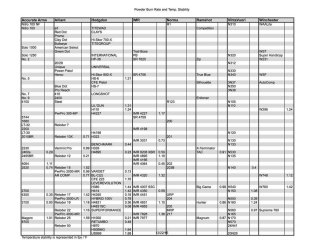Dear Members, I realize I have made the same mistake others have been called out for in my original posted request above. I have not supplied sufficient information to narrow the search for the information I seek, so I will attempt now to rectify that. I am going to do it by reposting (parts) of the dated posts to which I referred above, so as to fine tune the discussion. If the scientific research paper I seek can be located, we can all learn something.
First, additional background. While I appreciate the posting of
relative burn rate charts, they are just that:
relative. At one temperature and pressure, the charts are indicative of how fast one smokeless powder burns when compared to another smokeless powder. For example, Reloder 22 burns slower than Reloder 7. No one disputes that.
Since such charts are available practically anywhere, at least one in every reloading manual, that is not really useful information. What will be useful is to understand, mathematically, how the burn rate of
one brand/lot of powder changes as the temperature changes. To be precise, one can ask "how does the burn rate change for BL-C(2) when the ambient air temperature changes from 0 degrees fahrenheit to 100 degrees fahrenheit when using a .308 cartridge with a 165 grain Nosler Accubond bullet in a 24 inch barrel while holding humidity and elevation constant?
This scientific research has been conducted and published. Yes, I understand I may not be able to reproduce the exact conditions discussed in the publication. It is the findings that are of interest. For completeness, I will embed some of the original threads on this topic that led me to ask for the specific paper (previously) posted on the Defense Technical Information Center public website.
You will notice that there is no reference to
relative burn rates in the original post.
A short time later, on the same day, member (handle) 918v replied as follows:
This post elevated my blood pressure a little. Perhaps this is something systematic?
In another thread "Retumbo and Temps" I find this, posted by member Darkker on August 28, 2016:
"...apparently he hasn't looked at any of the work done by the Naval Warfare Testing Center in many decades. Or that 95+-some percentage of all American armed forces ammo is ball powder....
If you want science, and not some schmoe who thinks there is a difference between Bl-c(2) and H335, read Dr. Denton Bramwell's testing. He used to write for the note defunct Varmint Hunter magazine, but she of his articles on temp are still up at RSI. But yourself a Pressure Trace while your there and learn that no, no you can't "read signs" of pressure in brass."
See:
https://www.longrangehunting.com/threads/retumbo-and-temps.175048/#post-1227391
Here we are closing in on systematic research. The reference quoted above for the Naval Warfare Testing Center is what drove me into the Defense Technical Information Service portal. I have been unable to find any NSWC published research in there on burn rates and how they change in smokeless small arms powders as the temperature changes.
I have yet to scour the web for Dr. Denton Braswell. Back in the 1990s I was a subscriber to VH magazine. I don't have those issues to refer to now. I also do not recognize the abbreviation "RSI" in this context. I have discovered the papers posted from the DTIC site from member Darryle. Thank you for those. But I still seek the systematic research, especially anything on this subject from the Naval Surface Warfare Center.
I hope this update clarifies what I'm looking for. If I, or one of you can find it, I believe we will all benefit.
Yours;
-mouse

